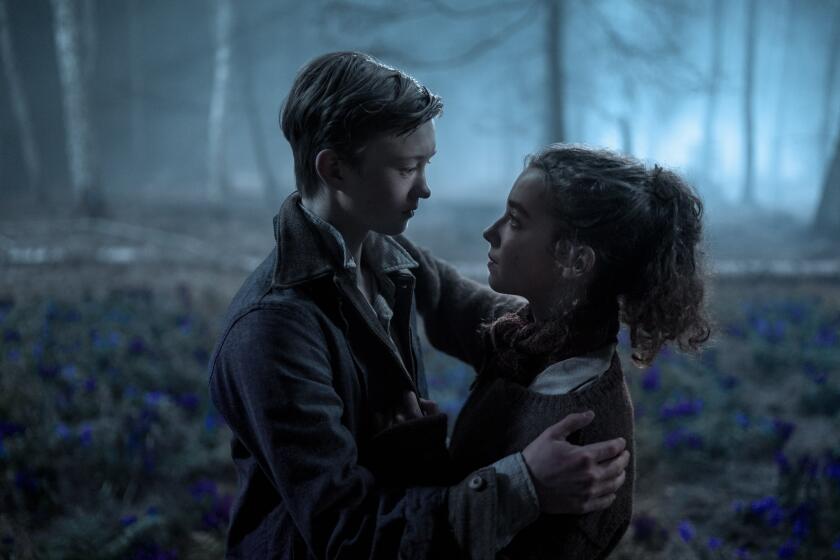‘Always in Season’ explores an America stained by lynchings and a legacy of racism
The 911 call came from beneath a smokestack off a rural highway: “I have a man hanging from a swing set.”
The caller grew panicked, her voice cracked. She cried out to God. When the police arrived on that morning in 2014, they found Lennon Lacy, a high school football linebacker, dangling by a belt his family said was not his own. Murmurs began that he may have been lynched, rousing sins that stretch back to slavery days, and forcing Bladenboro, N.C., a town once known for turpentine and cotton mills, to confront things it’d rather let be.
Jacqueline Olive’s “Always in Season” examines Lacy’s death and connects it — some may argue a bit too circumstantially — to a national legacy of racism and grim statistics: Between 1872 and the mid-1960s nearly 5,000 African Americans were lynched. The documentary does not conclude that Lacy was murdered, but it raises nettlesome questions about why the police judged the death a suicide, despite inconsistencies and the fact that Lacy was dating a white woman in a part of the country known for the Ku Klux Klan.
“The police did a rushed investigation four years ago,” said Olive, whose movie premiered to strong reviews in the Sundance Film Festival’s documentary competition this week. “A lot of the evidence was lost. A lot of the interviews and people who might have come forward are lost. So the community, as with historical lynchings, which often weren’t investigated at all, is left with speculations, stories and rumors. It’s hard for me to know what happened.”
The power of “Always in Season” is an eerie arc that latches present to past. Police shootings of black men and a surge in white nationalism are signs that the nation has yet to face the enduring specter of racism.
Olive traces this back as if following a trail of blood and injustice to lynchings decades ago, including the annual reenactment in Monroe, Ga., of the 1946 slayings of four blacks pulled from their car and shot. It was only 68 years between that crime and Lacy’s death, a time, the film suggests, when racial enmity, though less visible, remained potent.
Exploring the country’s violent bigotry, James Baldwin once noted, is to glimpse the shame, denial and conflicted soul of white America. The photographs of lynchings that haunt Olive’s film show hanged, battered, cut, castrated and burned black bodies. But looking out from below the suspended feet of the dead are scores of white faces — men, women and children — that appear as if posing for group portraits at macabre garden parties. No one turns away; they celebrate what has been done.
Many in Monroe, black and white, don’t want to revisit that time. Few of them attend the reenactment.
“Part of that is dissonance and part of that is the fact that it’s an indication that the power structure of white supremacy still exists there,” Olive said. “When I tried to interview some black people outside of their homes, I had to go inside because they didn’t want to be seen talking about a lynching that had happened there. And sometimes even in their homes they’d whisper. That’s not old fear.”
FULL COVERAGE: 2019 Sundance Film Festival »
Lacy’s story is more complex than the Monroe slayings. He was a big, genial adolescent, roaming his neighborhood till all hours. But he was troubled at times by his romantic relationship with a 32-year-old single white mother with a drug habit. He was built like a man, but perhaps not as emotionally mature as one. The couple broke up. The sting of it bothered him and he grew jealous of the man she took up with.
The night before he died his mother, Claudia, said he was at ease, preparing for his next football practice. In the hours and days after his death, inconsistencies began to challenge the police ruling of suicide. Lacy was found in different sneakers than the ones he left the house in. A mortician said that his head and arms bore the cuts and bruises of someone who was attacked. The belt around his neck, said his mother, was not his. Lacy lived about 100 feet from a man with white supremacist leanings; weeks before his death the KKK held a rally in a nearby county.
Sundance 2019 Film Festival: See the latest video interviews


Video: Behind the scenes of the L.A. Times 2019 Sundance photo/video studio

Video: The 2019 Sundance Film Festival Boomerang Supercut

Video: How do you make the most of a small budget?

Video: Cast and filmmaker discuss trusting each other while shooting 'Premature'
3:12

Video: 'Brittany Runs a Marathon' breaks conventions and stereotypes

Video: Jillian Bell is tired of getting scripts about body image issues

Video: Jillian Bell lost 40 pounds for her role in 'Brittany Runs a Marathon'

Video: 'Brittany Runs a Marathon' actors break out of their sidekick roles
Lacy’s family and an NAACP lawyer asked the FBI and the U.S. attorney’s office to investigate. They did and found no evidence of a crime. The Fayetteville Observer reported that federal investigators determined Lacy could have hanged himself on the swing set and that a belt at the scene was similar to one he had been photographed in. Olive said authorities declined to be interviewed, but the film would have benefited from a more thorough accounting of how investigators drew their conclusions.
“If you knew in your heart and in your mind that someone took your child’s life, how far would you go to get to the truth? How soon would you let it go?” Claudia Lacy says in the film. “A neighborhood is supposed to be a connection of your extended family. Someone in your family gets hurt, you hurt. And until this wound is fixed and healed, this neighborhood will always hurt and always be an open wound.”
Lennon Lacy’s death lingers in Claudia’s house, and along the railroad tracks, playgrounds and across the fields of Bladenboro, population about 1,700. There are two versions of what happened, and Olive, co-director of the 2009 documentary “Black to Our Roots,” said the racial fault lines in North Carolina and across the country serve as an unsettling backdrop.
“It’s time for this country to move toward a national movement [of] justice and reconciliation,” she said. “Part of the reason we haven’t is because it is so deeply entrenched in who we are as Americans. People often put a wall between the past and present because it makes it more comfortable to live, but it’s not unconnected to what’s going on now.”
Twitter: @JeffreyLAT
ALSO
‘Vice’ and ‘Leave No Trace’ expose the sins and casualties of the Iraq war
More to Read
Only good movies
Get the Indie Focus newsletter, Mark Olsen's weekly guide to the world of cinema.
You may occasionally receive promotional content from the Los Angeles Times.











